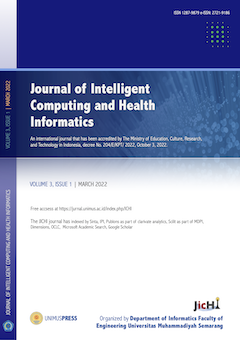Non Contact Temperature Monitoring System to Optimize Health Working Environment Based on IoT
(1) Universitas Islam Majapahit, Mojokerto
(2) Universitas Islam Majapahit
(3) Universitas Islam Majapahit
(*) Corresponding Author
Abstract
During the ongoing COVID-19 pandemic, monitoring body temperature is a crucial concern for the community, and it serves as an essential step in understanding the health condition of an individual's body. The workers in environments that involve physical contact and are prone to dirt are at a higher risk of contracting COVID-19. In this study, we created a body temperature detector to optimize the working environment in the waste processing area of Mojokerto Regency. Several modules and devices have been utilized, including the Arduino Uno R3 module, an ultrasonic sensor for object detection and temperature sensing, MLX90614 for detecting body temperature, and a buzzer system. The SDLC (Build & Fix design) method was employed to simulate the actual conditions at the Randegan Landfill in Mojokerto. Consequently, the designed IoT device can automatically send information and provide follow-up through a network of various functions. It can be concluded that the developed body temperature detection device has the potential to minimize the risk of contracting COVID-19 and enhance healthier and more productive working conditions.
Keywords
Full Text:
PDFReferences
Aboejoewono, A. (1985). Pengelolaan Sampah Menuju ke Sanitasi Lingkungan dan Permasalahannya; Wilayah DKI Jakarta Sebagai Suatu Kasus. Jakarta.
Dinas Kebersihan Kota DKI Jakarta. (1985). Permasalahan dan Pengelolaan Sampah Kota Jakarta. Jakarta.
Murtadho, D. dan Sa’id, E. G. (1988). Penanganan Pemanfaatan Limbah Padat. Sarana Perkasan. Jakarta.
Tiwow, Clara., dkk, (2003). Makalah Pengantar Falsafah Sains (PPS702), Program Pasca Sarjana IPB, Bogor Posted: 1 May 2003.
Danang Setiaji, (2018), Apa Itu Smart City dan Tantangan Penerapannya di Indonesia. https://id.techinasia.com/apa-itu-smart-city-dan-penerapan-di-indonesia
Naashir, (2014). Smart City, https://naashir.wordpress.com/2014/11/07/smart-city/
NN., (2017), Smart City 4.0, https://berkeleysmartcities.com/
Shinta Esabella, (2016), Menuju Konsep Smart City, Universitas Teknologi Sumbawa, NTB.
Benazzouz. Y, Munilla. C, Gunalp. O, Gallissot. M, Gurgen . L, (2014). Sharing User IoT Devices in the Cloud, in IEEE World Forum on Internet of Things (WF-IoT), pp. 373-374.
IEEE, (2018). IEEE Standard for Adoption of Open Fog Reference Architecture for Fog Computing," in IEEE Std 1934-2018 , vol., no., pp.1-176, 2 Aug 2018.
Tang. B, Chen. Y, Hefferman. G, Pei. S, Wei. T, Yang. Qing (2016). Incorporating Intelligence in Fog Computing for Big Data Analysis in Smart Cities, in IEEE Transactions on Industrial Informatics, pp. 1-11.
V. C. G¨ung¨or, D. Sahin, T. Kocak, S. Erg¨ut, C. Buccella, C. Cecati, and G. P. Hancke, (2011) Smart grid technologies: communication technologies and standards, IEEE transactions on Industrial informatics, vol. 7, no. 4, pp. 529–539.
W. Su, H. Eichi, W. Zeng, and M.-Y. Chow, (2012) “A survey on the electrification of transportation in a smart grid environment,” IEEE Transactions on Industrial Informatics, vol. 8, no. 1, pp. 1–10.
H. Chourabi, T. Nam, S. Walker, J. R. Gil-Garcia, S. Mellouli, K. Nahon, T.A.Pardo, and H.J.Scholl, (2012) “Understanding smart cities: Anintegrative framework,” in International Conference on System Science (HICSS), pp. 2289–2297.
Article Metrics
Abstract view : 255 timesPDF - 44 times
DOI: https://doi.org/10.26714/jichi.v4i1.11163
Refbacks
- There are currently no refbacks.
____________________________________________________________________________
Journal of Intelligent Computing and Health Informatics (JICHI)
ISSN 2715-6923 (print) | 2721-9186 (online)
Organized by
Department of Informatics
Faculty of Engineering
Universitas Muhammadiyah Semarang
W : https://jurnal.unimus.ac.id/index.php/ICHI
E : jichi.informatika@unimus.ac.id, ahmadilham@unimus.ac.id
This work is licensed under a Creative Commons Attribution-ShareAlike 4.0 International License.









